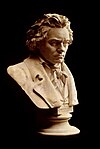The Guevara Lock
Of the holdings of the center, the most well-known is probably a lock of Beethoven's hair known as the Guevara Lock. The lock was cut on March 27, 1827, one day after Beethoven's death, by Ferdinand Hiller, a German composer and conductor who had traveled to Vienna to spend time with Beethoven before he died. Hiller later made the lock a gift to his son Paul, who explained its history on the back of a locket containing the hair. After that, the ownership of the lock is uncertain, until it resurfaced in 1943 as payment to a Danish doctor named Kay Alexander Fremming for medical treatment given to Jews escaping Nazism. [6]
In 1994, the Fremming estate auctioned the lock at Sotheby's in London for £3,600 ($7,300 including commission) to four members of the American Beethoven Society: Dr. Alfredo Guevara, Ira Brilliant, Dr. Thomas Wendel, and Caroline Crummey. The lock was named in honor of Dr. Guevara, the principal investor, who kept a small portion of the hair and donated the rest to the Center for Beethoven Studies. The remaining investors donated their entire portions to the center. The original lock consisted of 582 brown, white and grey hairs, from three to six inches in length. The Center for Beethoven Studies has 422 of those hairs, along with the original locket used by Hiller. [6]
In 1996, Brilliant and Guevara contacted the Health Research Institute - Pfeiffer Treatment Center in Naperville, Illinois to perform tests on some of the hairs from Dr. Guevara's share. Dr. William Walsh headed the project, and his report revealed concentrations of lead 100 times the norm in Beethoven's hair, leading many to theorize that lead poisoning contributed to his poor health and perhaps his death. [2] [7]
The history of the lock and the clues it yielded on Beethoven's health have been chronicled in the nonfiction book Beethoven’s Hair, by Russell Martin. [2] There was also a documentary of the same name made for Canadian television. In 2005, the documentary won several Gemini Awards, including Best Writing in a Documentary Program or Series and Best Direction in a Performing Arts Program or Series. [8]



